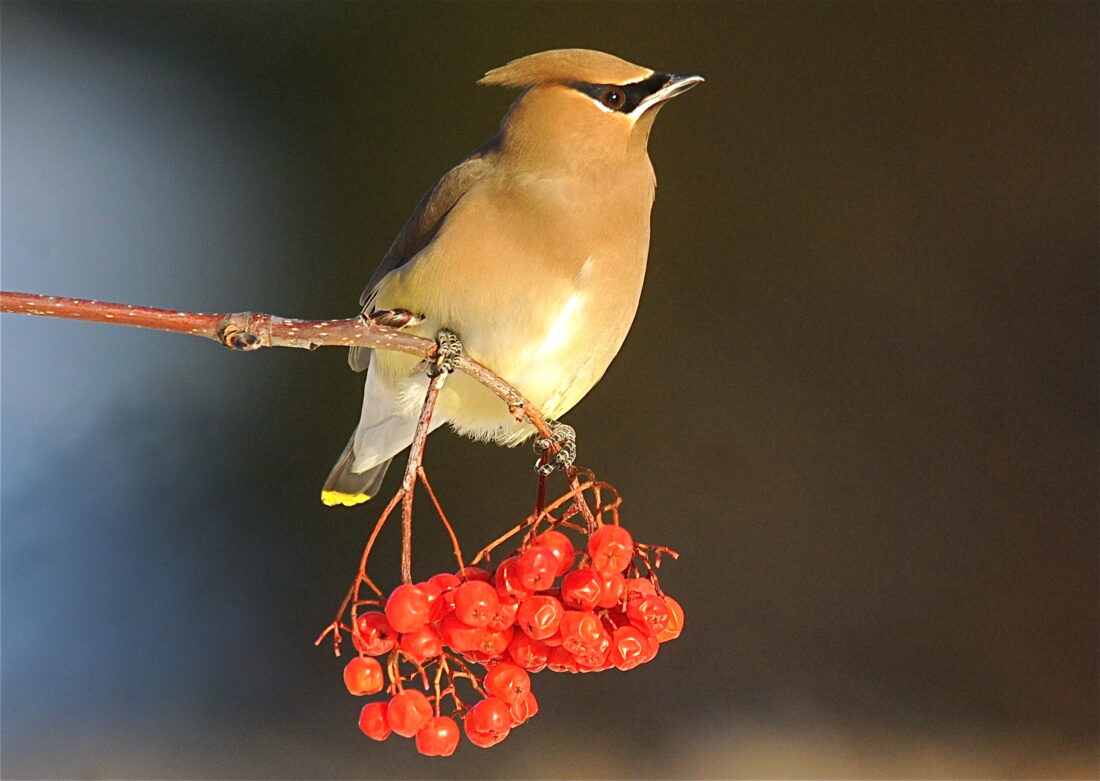Summer: Much to take in with senses

A cedar waxwing is shown. (Scot Stewart photo)
“Not humans, but birds often witness the most beautiful mornings in this world!” — Mehmet Murat Ilda
The middle of August found the Upper Peninsula quickly. Many have marveled (again) at how fast the summer season has run! Most mornings have been clear, surprisingly from the smoke of the western wildfires, and still deliciously warm — compared to the mornings to come. They are perfect mornings to arise early and head to a meadow trail, a path in the woods, or the beach at Lake’s edge and soak up these precious mornings.
There is much to take in with all the senses.
Among the birds many can currently enjoy are northern cardinals, blue jays, and cedar waxwings. All have crests and can still be prominently heard. Because of their feeding habits near and on the ground, most U.P. cardinals are found in and around town. They are frequent feeder visitors, especially in wintertime with snow cover, when food for them is scarce. Several in Marquette are still singing in early morning, indicating they may be working on a second brood or simply tending their territory.
Blue jays have definitely made their presence known in several neighborhoods the past three weeks. Families of up to eight have commandeered several feeding stations in Marquette and have been able to clean up a suet cake and a significant amount of black-oil sunflower seed each day. Up to three jays ride the suet together and a few young have perched nearby begging for food from parents, still behind in working on their own foraging skills.
At several feeding stations the jays are competing with European starlings and common grackles, with both quite aggressive, and the slightly larger grackles winning the battle for top of the pecking order. A surprising number of both hairy and downy woodpeckers are also being seen at feeders; a bit unusual for this time of year. The biggest attendees at these feeding frenzies seems to be a family of crows that have taking over one feeding station.
Cedar waxwings are the most subtle of the three crested birds. Lacking the flashy crimsons of the cardinals and the bright mix of blues of the jays, their plumage is just as spectacular in a more unique fashion. Their breasts are yellow, their backs a lovely rusty tan. They have black masks, a yellow tip to their tails and bright red waxy secretions on their wing tips. Waxwings are late nesters and very social. Although their calls are weak, nasally whistles, they are usually not difficult to find. They often sit atop trees in summer, often close to water and act like flycatchers, waiting for winged insects to coast by before darting out to grab them on the wing.
Birders across the U.P. have reported seeing small groups on their report lists, with one from Alger County spotting 30. Waxwings are also professional fruit eaters, and can currently be found eating serviceberry, honeysuckle, cherry, and newly ripening mountain ash fruits. Their relationship has produced a number of really interesting notes according to Cornell’s All About Birds page, https://www.allaboutbirds.org/guide/Cedar_Waxwing/overview. Waxwings have yellow tail tips that can be orange in locations where the birds eat introduced fruits of honeysuckle. Because their young nestlings are often fed lots of fruits, cowbirds in the same nests rarely survive on the same diet. Lastly, they are one of the few species of birds that allow fruit seeds to pass through their entire digestive system, instead of being regurgitated. This allows scientists to calculate the time it takes waxwings to digest some fruits.
The mountain ash crop appears to be quite plentiful this year, as are many seed and fruit crops. Watching a mature tree can be quite an experience, and in the next two weeks birders should be able to find cedar waxwings, starlings (unfortunately), brown thrashers, gray catbirds, house and purple finches, rose-breasted grosbeaks, robins, hermit, and Swainson’s thrushes, and even a warbler or two feeding on the fruits.
A number of birders have recently reported a return of hummingbirds to their feeders. While females are incubating eggs, they keep a low profile and like the males do spend a lot of time hunting small insects, like aphids, and spiders for the protein they need. They also work diligently to protect their home territory so when the young do fledge they can continue to find the food they need close to home.
Female ruby-throated hummingbirds lack the red throats and young hummingbirds have grayish chests appearing just a bit less obvious.
Young males may sport one or two tiny red throat feathers and rows of small gray-green throat feathers to foretell their future beauty.
Another species has returned again to Marquette for a probably short visit this summer. A great egret was seen on the Dead River above the Tourist Park Lake. Great egrets are large wading birds, nearly the size of great blue herons, and have been extending their range northward. They have nested on islands on the Menominee River in recent years after making appearances along Lake Michigan north of the Wisconsin border and are now regularly being seen along the shoe between Rapid River to Manistique.
Last year five egrets appeared in north Marquette in August, dividing their time between fields along Lakeshore Boulevard where they foraged for insects like grasshoppers, and nearby creeks, rivers, and ditches where they hunted for small fish and invertebrates like dragonflies and crayfish.
So, get out and enjoy those early morning hours with them, the dragonflies, and other foraging animals!
EDITOR’S NOTE: Scot Stewart is a teacher at Bothwell Middle School in Marquette and a freelance photographer.


